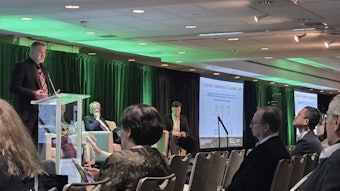Technology as the practical application of knowledge has had an undeniable impact on the way we live. One has only to look back 100 years to a time when there were no televisions or telephones, no sunscreens, advanced skin care or plastic packaging. Trade and consumer press have expanded coverage of the latest advances in ingredients, delivery systems, preservatives, fragrances and much more. Certainly, a day doesn’t go by without news of the latest gadget for TV watching/music listening/Web surfing/phone calling all in the palm of your hand. The pace of technology has been on a steep upward trend for the past 50 years, and shows no signs of abating; in fact, the opposite is the more likely scenario: acceleration. Advances have come organically, building upon technologies of previous eras.
Tom Johnson blogs about emerging technologies—including blogging (itself), podcasting, wikis, open source and Web 2.0—and how they can be applied to his specialty, technical writing (www.idratherbewriting.com).
In a post dated July 24, 2007, he wrote that “Paul Saffo, a well-known figure on future studies, explains that every 30 years or so, a new technology transforms society. In the earlier part of the 20th century, the transforming technology was chemistry [medicines, plastics]. Then developments in physics followed [atomic energy, circuits]. Now information technology is transforming society. In the 21st century, the change will be biological.”
Certainly, the beauty industry has reaped major benefits from 20th century advances in chemistry and will continue to feel the impact as researchers explore and apply nanotechnology, biotechnology and more.
In that same blog post, Johnson wrote about a podcast in which the founder of a software application described the accelerated pace of new releases into the hands of users by saying “users like an accelerated development cycle. Software that stagnates, which isn’t updated but every year and a half, loses its appeal to users.”
Sounds a little like the beauty industry, doesn’t it? The constant need for new products on store shelves may be the industry’s single greatest challenge. Related challenges include how brand owners learn what customers want and how to help consumers get the most out of their products. The beauty of modern society is that three new technologies may hold some of the answers.
Makeup Matchmaker
What it is: On July 11, Hewlett-Packard (HP) showed off a new mobile color matching technology that the company says could change the way consumers shop for cosmetics. It can compensate for harsh lighting and zero in on the customer’s true skin color, complementing the services of makeup counter personnel.
How it works: A shopper at a cosmetics counter photographs herself using her mobile phone camera while holding a specially designed color chart. She sends the photo as an MMS (multimedia message) to a service set up to take the call. What happens next is described by HP: “Skin pixels are extracted from the color corrected image of the person’s face, and then compared to an existing database of previously captured and analyzed images of skin tones of real people.” Seconds later, the makeup customer receives a text message response with a recommendation on the shades that are best suited to her complexion.
“HP’s color matching technology provides retailers and consumer goods companies with a new, fun way to interact with customers and promote their products,” said Nina Bhatti, principal scientist, Digital Imaging and Printing Lab, HP Labs. “For those who shop for cosmetics, this technology gives them a virtual beauty consultant in the palm of their hands.”
This kind of technology is not entirely new. According to a review of the HP product found at the Web site of Technology Review, an MIT publication, “color matching algorithms have been used for years to maintain the color of images across devices such as cameras, computer monitors and printers. And the idea of using color matching algorithms to help people shop isn’t entirely new.”
HP is looking for brand owners and retailers to partner with to make the technology available to the buying public. More information is available at www.hp.com/hpinfo/abouthp/iplicensing/.
Barcodes for Packaging
What it is: In February 2007, Scanbuy, Inc. —a global provider of wireless commerce solutions—announced an exclusive agreement with DuPont Packaging & Industrial Polymers (P&IP) to license its interactive 2D barcode technology for packaging applications. How it works: When imbedded in product packaging, 2D barcode technology enables a myriad of consumer interactive applications directly from mobile handsets. One use could be in determining if a cosmetic is suited for an individual, along with more sophisticated uses like playing games and winning prizes.
“Smart packaging represents a key future packaging trend and opens up new opportunities that run the gamut from better inventory tracking to brand enhancement,” said John Hillenbrand, vice president, innovation and technology, DuPont P&IP.
As part of the agreement with Scanbuy, DuPont P&IP will be the exclusive marketer of Scanbuy’s interactive camera phone technology to the packaging industry. DuPont P&IP selected Scanbuy as its exclusive technology provider to commercialize and market Scanbuy’s interactive technology to select global brands under the DuPont banner.
According to a Scanbuy press release, a market study by NanoMarkets reported that the global smart packaging market will account for more than $1.1 billion in printable electronics components by 2011, growing to $4.2 billion by 2013.
Web Crawler
What it is: WiseWindow is a consumer and expert insight tool that crawls reviews, blogs and discussion boards to measure competitive brand and product sentiment over time to define and verbalize trends as consumers or experts see them. It also allows marketers to isolate relevant key words and phrases.
How it works: Marketers use the tool for new product development, product optimization, and as a complement to or substitute for focus groups and awareness and attitude studies. It is always current, accesses a larger base of consumers and is less expensive. Additionally, it can measure relative buzz for products, brands, celebrities and the attached associations.
According to Raulee Marcus, new business developer for the technology, one beauty expert was excited to see that the application can identify a terminal value, such as freedom, and see how it applies to their product category and find positioning opportunities. “Another expert was excited because they are having trouble with a sub-brand they just launched, and they now can see the source of the problem,” said Marcus.
Readers who want to learn more about WiseWindows, based in Santa Monica, California, can contact Marcus at [email protected].
Eyes on Tomorrow
The neat thing about new technologies is that they build on something that has come before. Who knows what may be next for mobile-activated color matching and customer interaction. Adapting novel technologies to use in the beauty industry is just the start. How it is used to build a brand is what really makes the difference.
References
1. www.technologyreview.com/Biztech/19034. (Accessed Aug 2, 2007).










